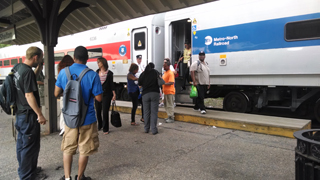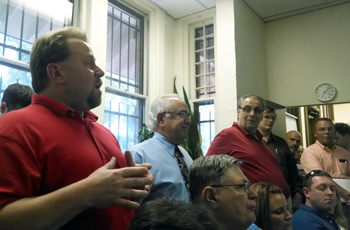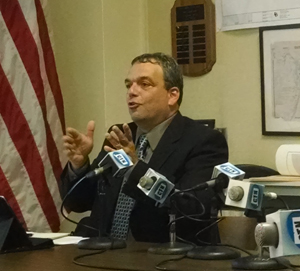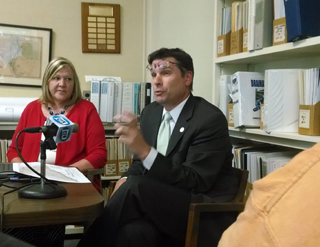 When Jeanne Iannocone gets on her homebound train from Stamford each evening, she can see a train follow closely behind hers on a parallel track.
When Jeanne Iannocone gets on her homebound train from Stamford each evening, she can see a train follow closely behind hers on a parallel track.
Iannocone’s train stops in Bridgeport, everyone gets off, then she gets on the train that’s been following them from Stamford in order to continue the trek up the Waterbury branch of the Metro North train line.
Why can’t she just get on that train in the first place?!?
It’s one of the idiocies of Metro North’s Waterbury line aired at a passenger meeting Wednesday at the Derby train station.
About 25 passengers and public officials packed the small meeting room of the Valley Council of Governments office to brainstorm short-term fixes to problems that plague their commutes.
Those problems include unclean bathrooms, frequent train break-downs, over crowded replacement buses, a lack of train routes, and a general feeling of disrespect.
“My motto has always been, just give us what Danbury gets,” said Jim Gildea, vice chairman of the Connecticut Commuter Rail Council, which organized the meeting.
Overall, the goal is to get more service in order to attract more riders, which, conventional wisdom says, will help boost the economy in the Valley.
Gildea, a Derby resident, said he will compile the complaints, and the council will host a follow up meeting in the fall.
Several local and state officials attended the meeting, including state Senator Joseph Crisco and state Representative Theresa Conroy. Derby Mayor Anita Dugatto and selectmen from Seymour were also present.
Gildea and several passengers referred to the Waterbury line as the “stepchild” of Metro North.
“The poor stepchild twice removed,” Rick Dunne, the executive director of the Valley Council of Governments, said.
Up in Litchfield County, residents drive to upstate New York to catch a train there, rather than drive the shorter distance to the Waterbury line, according to Sam Gold, the executive director of the Council of Governments for Central Naugatuck Valley.
“They’re not going to come down to Waterbury, even though it’s closer,” Gold said. “That’s ridiculous.”
Problems
Passengers cited several overlapping complaints.
 The infrequent train service between Bridgeport and Waterbury causes a cascade of issues for commuters.
The infrequent train service between Bridgeport and Waterbury causes a cascade of issues for commuters.
If Iannocone misses her connection in Bridgeport — say her train is late, while the other train arrives on time — she has to wait two and a half hours before the next Waterbury line train comes along.
Several passengers said they have missed buses that were sent in place of broken trains because of late connecting rides. Others say only one bus is sent to transport a train’s worth of passengers.
“I have literally ridden on the dashboard of the bus,” Lori Behan, of Southbury, said.
Passengers say the train car bathrooms are poorly vented, “disgusting” and sometimes leaking waste onto the train aisles.
“Maybe people would be willing to pay more if you give them something that looks better than an outhouse on wheels,” said John Sanford, who commutes from Naugatuck to Wilton every day.
Underlying problems
The short-term problems are complemented – and sometimes caused – by infrastructure problems with the line.
The Waterbury line runs a single track between Bridgeport and the Waterbury station. That means only one train can ride at a time.
 The train starts in Waterbury, and travels through Naugatuck down to the lower Valley before continuing on to Bridgeport.
The train starts in Waterbury, and travels through Naugatuck down to the lower Valley before continuing on to Bridgeport.
Then it comes back north. That’s what causes the two-and-a-half hour delay between runs.
Gov. Dannel Malloy on Monday announced $6 to $7 million in funding for a signalization design project on the line, which would improve safety and allow more trains to use the tracks.
“The announcement of funding for full signalization is a big step,” Dunne said.
But it could be three years until the designs are is complete, according to Gildea. And then they have to find money to actually build the system.
“Studies are great. I love studies,” Gildea said. “But we need service as well.”
Better service could increase ridership, he said.
Gildea cited ridership numbers increasing by 120 percent between 2004 and 2012.
In April 2008, adding just one more morning line increased daily rides by 40 percent, he said. Adding the signalization could increase the daily rides by 1,000 each day, Gildea said, citing a 2012 study.
Mobilization
In May, Metro North cancelled the popular express train to Stamford, but passengers pushed back.
Four weeks later, the route was returned, Gildea said.
That’s the kind of mobilization the Connecticut Commuter Rail Council is looking for regarding the other issues.
 Dunne said the state Department of Transportation is always looking at which road or rail projects to fund — and the Valley has a lot of competition.
Dunne said the state Department of Transportation is always looking at which road or rail projects to fund — and the Valley has a lot of competition.
“What we don’t have here is a movement,” Dunne said. “You’re in huge competition right now for money. Like it or not, it’s between highway and rail.”
[View the story “Waterbury Branch Riders Vent” on Storify]